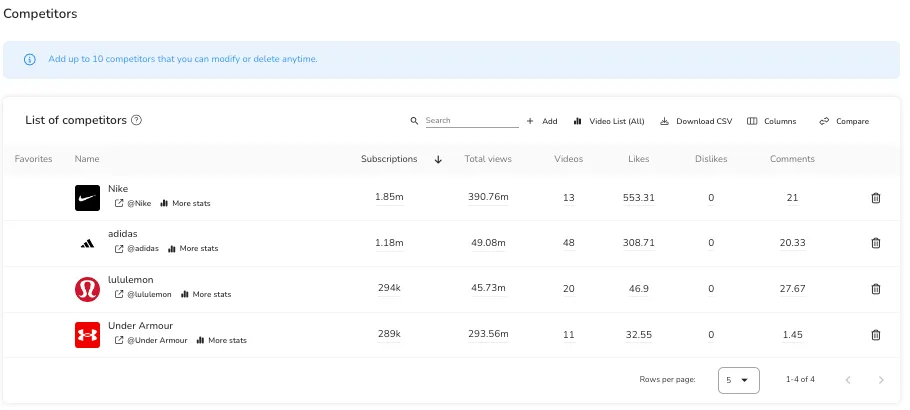How to Conduct a YouTube Competitor Analysis in 4 Ways

Watch your competitors closely. Their wins and losses reveal your next move. Analyzing YouTube rivals sharpens your edge. Use the right tools and make every view count! Sounds easy, right? It actually is, and we are going to show you how to conduct a YouTube competitor analysis in a few different ways.
To understand the competitive landscape of your business, you can’t avoid understanding how your competitors are performing, even as scary as it may seem. When envisioning strategies to improve your YouTube video views or even rank content, analyzing your YouTube competitors will help you focus on your strengths and weaknesses.
What’s a Competitor Analysis on YouTube?
A competitor analysis on YouTube is the process of analyzing, researching, and comparing how your competitor’s content, engagement, keywords, tags, etc. match up to your own. During this, you can see where your competitors shine and what they may have missing. It can then help drive your marketing strategies and focus on your value proposition to uniquely position your videos on YouTube.
YouTube is no doubt the largest video entertainment platform in the world with more than 2 billion monthly active users. Brands and businesses are utilizing this platform to increase engagement, position their brand on search results, and create communities that convert.
This should be conducted when creating your YouTube marketing strategy and evaluated frequently so you can measure your success. What does success look like on YouTube? Well, this is where a competitor analysis comes in to help.
What Are The Benefits of a Competitor Analysis?
You may be wondering, why would focus on our competitors if we could focus on our own brand strategies? This is a common misunderstanding that many brands need to pay more attention to when planning their strategies, content, and campaigns. Without analyzing the market at large, it’s difficult to understand who you’re even competing with in terms of sales, publicity, social media engagement, influencers, etc.
Seeing which videos, brands, or creators are ranking in search engines, posting similar content to your niche, and gaining high engagement on YouTube will give you content ideas on how you promote your brand and what you can do better.
If you’re looking to boost your brand’s video content strategy, consider these advantages of conducting a competitor analysis:
Monitor Trends and Content Ideas
When conducting industry research about your product or service, you will likely come across your main competitors. This is because they create content related to your audience’s ideal search intents, making their content visible to prospective customers.
The idea is never to “steal” content from other creators or brands. Rather, it’s to research what is trending, which content topics and formats have received the most engagement, and how their audience reacts. It’s a guilty pleasure really, a harmless snoop. Then, you can take back your learnings and come up with fresh content ideas that align with your brand.
Let Your Unique Value Proposition Shine
A competitor analysis will unlock that “aha” moment so your brand’s unique value proposition can come to life. What do you offer that your competitors don’t? What makes you stand out? By asking yourself these questions, you can create true content for your brand while still creating that competitive edge. You can also continue to highlight your brand strengths and see in which areas you can improve.
Benchmark Your Brand Goals
With the data, you can compare your competitor’s metrics against your own and continue to measure your channel’s growth. It can also serve as a motivational factor to hit set numbers and goals. However, don’t become discouraged if your numbers fall short of your competitors. Success doesn’t necessarily mean you have more engagement, video views, or subscribers than your competitors.
How to Perform a YouTube Competitor Analysis in 4 Steps
Now here comes the juicy part, performing your YouTube competitor analysis. We want you to think of this research as a healthy “stalking”. It all starts with finding the brands and influencers who are killing it right now within your niche.

#1: Detect your top YouTube competitors
First, you need to create a list of your top competitors. This initial list can start big and doesn’t necessarily need to be your top competitors on YouTube. While many brands are active on YouTube, some aren’t, so it’s important to see which of your competitors you’re competing with on this platform.
Start with a basic search on YouTube with keywords, hashtags, and topics that reflect your brand’s product or service. Which videos appear among the first results? Are any of these your direct competitors? Make sure to search by keywords and see which results appear among Shorts. What you really want to look for are:
- Subscriber count
- Channel age
- Brand assets
- Video frequency
- Content types
- Audience engagement
🔍 Pro Tip: Create a spreadsheet to track your top 5–10 competitors, including their metrics and content types.
#2: Analyze their channel and videos
Now it’s time to become the Sherlock Holmes and Nancy Drew of the social media identity world. This is the most time-consuming phase, but also one of the most important. Once you have a narrowed-down list of competitors, start going channel by channel. Start by taking note of their channel as a whole. When analyzing YouTube videos and their channel, consider these questions:
- What keywords and phrases do they use in video titles and descriptions?
- What type of videos are they posting? (Tutorials, reviews, educational, etc.)
- What do their thumbnails look like?
- What does their audience engagement style look like?
- Which videos have higher engagement and views?
- How many subscribers does their channel have?
- How often are they uploading videos?
- Who are they collaborating with or what guests make appearances?
- How do they promote their YouTube content on other social media platforms?
- Which content formats are they using? (Shorts, lives, podcasts, playlists, community posts).
- Are there any trends, commonalities, or frequently asked questions when users comment?
The goal here is to be a sleuth for what this competitor’s audience is looking for and what they prefer to engage with. While your audience will and should different from your competitors, you can expect many similarities.
You can also find your competitor’s exact engagement rates, subscriptions, total views, likes, comments, and top-performing videos using Metricool’s competitor analysis tool.
#3: Use a competitor analysis template for reference
You can’t remember all of the metrics, insights, and patterns you have found among your competitors’ channels. Therefore, we encourage you to use a competitor analysis template to keep track of this data and use it as a constant reference. You can utilize our FREE competitor analysis template for a pre-formatted guide to jot down the key information about your competitors.
You are also going to do a lot of evaluating with the data in your template. Metrics like views per video, like-to-dislike ratio, comments count, shares, and watch time (estimated). Manually review top videos for comment sentiment and viewer feedback. Compare average views per video to the number of subscribers (engagement rate).
All of this is going to come in so much handy! Especially when you want to know exactly which topics are generating the most buzz, how audiences respond to different content formats, and what kind of CTAs (calls to action) are driving engagement.
🔍 Pro Tip: Use the “Other videos your audience watched” feature to see what content your shared audience enjoys.
#4: Refine your YouTube content strategy
You now have the key information on how your competitors use their YouTube channels to market their brands, which content works best for their audience, and where they may have downfalls, also known as content gaps. This data will help you organize your YouTube marketing strategies or create one from scratch if you haven’t yet started.
Then you can build your content plan including video ideas, posting frequency, video types, formats, etc. This is where you can get creative and play around with content ideas.
Top YouTube Competitor Analysis Tools
There is much more than meets the eye when you are analyzing a competitor’s YouTube channel. Thanks to the internet, there are a mass amount of tools (many FREE) that can perform more advanced and in-depth analysis for you.
Start by using tools that are designed specifically for YouTube Analysis. Even though it is primarily for you own channel, YouTube Analytics will show you how your videos perform compared to other creators in your niche. Also, using the “Research” tab in your YouTube Studio lets you explore trending topics and what specific keywords your competitors are ranking high for.
You can also install some very helpful browser extensions like TubeBuddy that will provide you with quality data available on YouTube channels. A free tool that even Metricool uses is Google Trends, which helps understand your audience demographics. But, what you are REALLY in need of is an all-in-one tool that can deliver you ALL of the following information:
- Key Performance Indicators (KPIs) which include trends in viewer count, how many likes, comments, and shares as a percentage of views, watch time, subscriber growth rate, etc.
- Click-Through Rates (CTRs) are data that you can typically do yourself… just take the total number of clicks a video has and divide it by the total impressions, and multiply that number by 100. (So a video with 1,000 views that got 100 people to interact with has a 10% CTR)
- Search Engine Optimization (SEO) will analyze the correlation between keywords used and the performance those videos get. You also want a tool that generates long-tail keywords and trending hashtags for you!
- Brand Mentions should be monitored across all social media platforms. This keeps tabs on conversations and sentiment around the specific topics and brands in your niche.
Advanced Tips to Outrank Competitors on YouTube
Once you’ve gathered your data, it’s time to act. Here’s how to turn insights into impact:
🔥 Content Creation
Fill content gaps with high-value videos.
Create series or playlists to boost watch time.
Use storytelling to increase retention.
🔥 SEO Optimization
Use LSI keywords (Latent Semantic Indexing) in descriptions.
Optimize thumbnails for CTR (Click-Through Rate).
Use pinned comments to link to other videos or playlists.
🔥 Community Building
Respond to comments to boost engagement.
Host live sessions or Q&As.
Collaborate with micro-influencers in your niche.
🔥 Performance Monitoring
Set KPIs (Key Performance Indicators) like CTR, watch time, and subscriber growth.
Use YouTube Analytics to track progress.
Adjust your strategy monthly based on performance data.
Analyze YouTube Competitors with Metricool
Metricool is an all-in-one social media management platform built with the tools for your brand to manage, analyze, schedule, and optimize your social media platforms. Our social media competitor analysis feature allows you to search your top competitors across Facebook, Instagram, X (Twitter), YouTube, and Twitch. Breaking down their engagement rates, interactions, and top-performing content, you can automate your competitor’s data for an easy, yet insightful analysis.
Add up to five competitors for FREE and up to 100 for any Premium plan at Metricool. You can also compare competitors against each other to see how they compare. Create your FREE Metricool account to assist your YouTube competitive analysis, view your channel messages and comments, and monitor your video analytics.

FREE YouTube Competitor Analysis
Metricool is your social media dashboard filled with more
analytics and metrics you could ever want!

